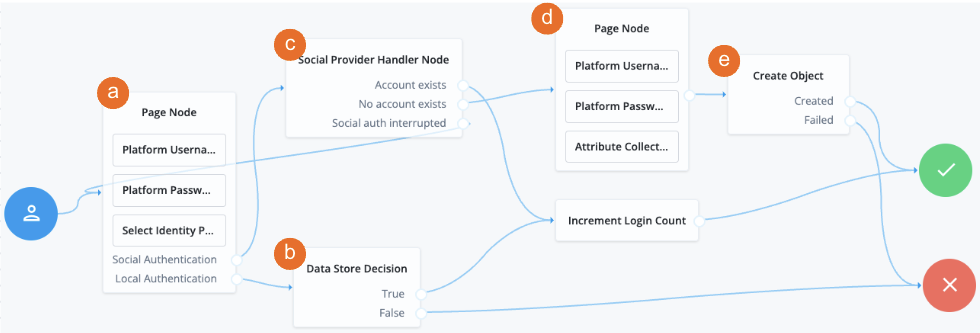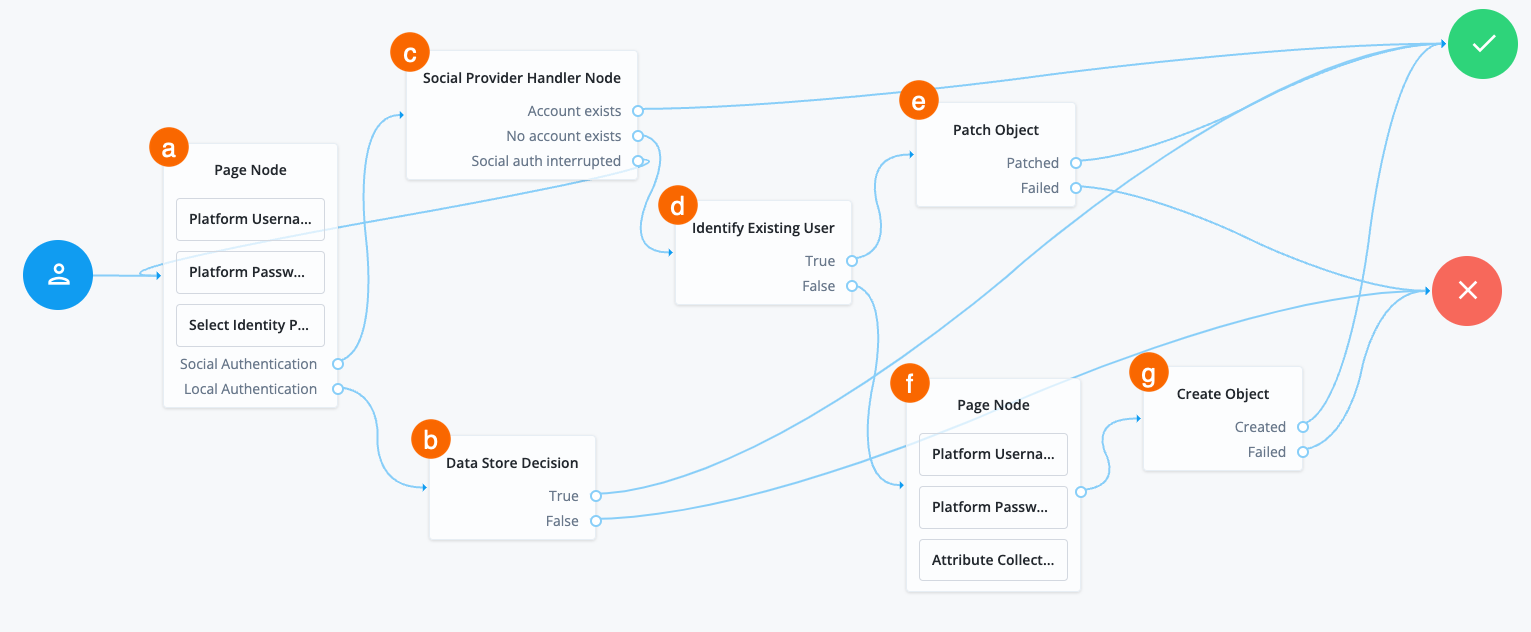Social Provider Handler node
The Social Provider Handler node attempts to authenticate a user with an identity provider they select in the Select Identity Provider node. The Social Provider Handler node collects relevant profile information from the provider, transforms the profile information into the appropriate attributes, and returns the user to the journey.
Compatibility
| Product | Compatible? |
|---|---|
Advanced Identity Cloud |
Yes |
PingAM (self-managed) |
Yes |
Ping Identity Platform (self-managed) |
Yes |
Inputs
This node reads the user’s selected social identity provider from shared state.
Implement the Select Identity Provider node before this node to capture the social provider name.
Dependencies
-
The Social Identity Provider service must be configured with the details of at least one social identity provider.
-
The user must have selected a social identity provider in a previous node in the journey.
Configuration
| Property | Usage | ||
|---|---|---|---|
Transformation Script (required) |
The normalization script of each provider maps that provider’s attributes to a profile format PingOne Advanced Identity Cloud can use. The transformation script then transforms the normalized social profile to a managed object. Select Review the sample script (normalized-profile-to-managed-user.js) for a list of bindings.
|
||
Username Attribute |
The attribute in the underlying identity service that contains the username for this object. |
||
Client Type |
The client type you’re using to authenticate to the provider. Select one of the following:
|
||
Store Tokens |
When In some cases, the social provider requires these tokens, for example, to revoke user authorization. If you choose to store tokens, you can configure a Scripted Decision node later in the journey to handle your social provider use case. Default: |
Outputs
-
If no profile information is returned from the social provider, the journey follows the
Social auth interruptedoutcome. -
If the node retrieves profile information from the social identity provider, it transforms a normalized version of the profile and stores it in
objectAttributesin transient state. -
To link existing users, the
aliasListis updated and saved toobjectAttributesin transient state. -
The node stores the social identity subject as the
usernameboth directly in shared state and in itsobjectAttributes. -
The node also updates
socialOAuthDatain transient state with all existing node state, social provider data, and associated tokens.
| Make sure you copy required transient data to shared state because all transient data is removed if the node is followed by an interactive page later in the journey. |
Outcomes
Account exists-
Social authentication succeeded, and a matching Ping Identity account exists.
No account exists-
Social authentication succeeded, but no matching Ping Identity account exists.
To ensure existing users are dynamically linked, connect the
No account existsoutcome to an Identify Existing User node followed by a Patch Object node to create the link as demonstrated in Example 2: Social Provider Handler node with dynamic linking. Social auth interrupted-
The user interrupted the social authentication journey after the node requested profile information from the social identity provider. This can happen in the following situations:
-
The user clicks the Back button in their browser from the social identity provider’s login page
-
The user clicks the Cancel button on the social identity provider’s login page
-
The user re-enters the journey URL in the same browser window
In this case, the node routes the user back to the Select Identity Provider node to select a social identity provider again.
-
Examples
Example 1: Social Provider Handler node in a social authentication journey

a The Page node containing the Select Identity Provider node prompts the user to select a social identity provider or to authenticate with a username and password.
b If the user selects local authentication, the Data Store Decision node takes care of the authentication.
c If the user selects social authentication, the Social Provider Handler node does the following:
-
Routes the user to the selected social provider to authenticate there
-
Retrieves the user’s profile information, and transforms it into a format that PingOne Advanced Identity Cloud can use
-
Assesses whether the user has an existing identity in PingOne Advanced Identity Cloud
-
If the user has an existing identity, authenticates that identity
-
If the user doesn’t have an identity, routes the user to another page node
-
If the user interrupts the social authentication, routes the user back to the Select Identity Provider node
-
d The nodes on the page node request the information required to register a new identity.
e The Create Object node creates the new identity in PingOne Advanced Identity Cloud.
Example 2: Social Provider Handler node with dynamic linking
This example shows a social authentication journey with dynamic account linking.

a A Page node contains the Select Identity Provider node node that prompts the user to select a social identity provider or to authenticate with a username and password.
b If the user selects local authentication, the Data Store Decision node takes care of the authentication.
c If the user selects social authentication, the Social Provider Handler node does the following:
-
Routes the user to the selected social provider to authenticate there
-
Retrieves the user’s profile information, and transforms it into a format that PingOne Advanced Identity Cloud can use
-
Assesses whether the user has an existing identity in PingOne Advanced Identity Cloud
-
If the user has an existing identity, authenticates that identity
-
If the user doesn’t have an identity, routes the user to the Identify Existing User node
-
If the user interrupts the social authentication, routes the user back to the Select Identity Provider node
-
d The Identify Existing User node checks if the user exists in PingOne Advanced Identity Cloud using the Identity Attribute specified and does the following:
-
If the user exists, routes the user to the Patch Object node
-
If the user doesn’t exist, routes the user to another page node
e The Patch Object node updates the existing user to create the link.
f The nodes on the page node request the information required to register a new identity.
g The Create Object node creates the new identity in PingOne Advanced Identity Cloud.